#Nawabs kitchen
Explore tagged Tumblr posts
Text
Krishna: a character adored for over two thousand years, revered as one of the most significant political masterminds of the ancient world with his words forming the philosophical core of the country today. Concurrently, he is the god shrouded in inimitable domesticity- as a friend, a lover, and a child. No other deity in the Hindu pantheon has probably achieved as dear a position in the hearts of people as this flute-wielding cowherd of Gokula.
For generations, he has shined as the muse of countless poetfolk, of unfinished business, of unspoken desires and of repressed lovers' qualms. In Meera's longing for her marble beloved, and in Kothai's dulcet dreams of a celestial wedding, Krishna blossoms not as a warrior, but rather as a confidante of young women- the keeper of all secrets.
Curse, o ye, this wedding of devotion,
For I was better off unmarried,
Writes the lovestruck Nawab Sadiq Hilm,
I was well enough at my mother's;
Oh, why did I pine for him?!
Who am I, or what: go ask Rizwan, the gatekeeper
For heaven has been rejected by my forebearers!
He says, in a nostalgic ode to the cowmaids from old tales. To the ones that massage the dust off their feet on Krishna's fevered forehead to soothe his illness, even as the apparent disrespect dooms their afterlives.
Jayadeva notes a more rugged form of Krishna, one that is almost hungry for love. His Radha smiles down upon Radharaman Dutta's kalankini. Of course, she would accept even infamy if it was in relation to her Krishna. However, in time, this epithet has been reclaimed as a celebration of the meteoric, tempestuous love that this unseemly duo had carved out for themselves of the pages of a mostly unwilling history.
Tagore's Krishna is mysterious, eagerly anticipated but rarely seen. Rather, here Radha's pining is crushing and all-encompassing, inherited from Chandidas' virahini. Radha's guttural desire to transform Krishna into herself, subjecting him to the same suffering that she undergoes as a woman in love with a furious ideology more than a man, reverberates eerily against the lighthearted cross-dressing tale of Surdas'.
As often as bards favour the songs extolling the love of the cowherd and the wedded maiden, Krishna's wives are seldom accorded any thought outside of Vasudeva's family tree. Their silence speaks to the stringent rules of a typical patriarchal household. Some of them do speak, and hence Satyabhama becomes conceited and Kalindi wayward. However, the mere few lines that they are mercifully allotted in the text are enough to speak to their resilience. The lines inadvertently hold up a window to the million unspoken words and unexchanged glances. It speaks to the long years, happy and sad. It speaks to the nights of waiting for the beloved to return. It speaks to the quiet lunches in curtained rooms and taste tests in the kitchen.
Each of Krishna's eight wives has their own life, and their own equation with Krishna. Each of their distinct personalities, coupled with their unique introductions to the prince has the potential to bring a distinct flavour to the story of Krishna, the statesman. The understanding that Krishna's heart belonged first to Vrindavana and then to his ambition, must have weighed somewhat on their hearts and yet, the choice to patch up the battle-hardened cowherd, after every blow, sans complaint, and send him out into the world as the architect of history, must have demanded restraint.
The distinct turn of events that brings each of the chief eight queens to Krishna's is quite interesting. Rukmini, the first, demonstrates heart, even if it is born out of desperation. Seizing control of her life, she sends a message, relying solely on rumours of his compassion. Her gamble yields returns manifold as Krishna not only rescues her from an unwanted marriage, but instates her as his chief consort, elevating her, alongside himself, to a divine status. Far from the impulsiveness of her youth, Pandhari's Rakhumai, astute beside her beloved, proudly bears a conch-shell, calling for harmony and community. In life as well, Rukmini brings to Krishna much needed stability, and oversees the blossoming of the city of Dwarika as well as Krishna's growing household.
Jambavati and Satyabhama are given in marriage to the prince by their respective fathers and do not seem to have much of a voice at the time. Jambavati fulfills an ancient destiny, a forgotten promise, then going on to mother the child that ultimately brings about the demise of the Yadava clan. Satyabhama, though often maligned with unfair accusations, is self-reliant. Making no attempt to hide herself from the eye of society, takes her rightful place beside Krishna, not on a throne, but by his side in battlefields. Kalindi however, is an extremely interesting character in Krishna's story. Enmeshed between mortal and divine, she exists as neither. Chancing upon the prince, she unabashedly declares her intentions to be married, and yet she is uncharacteristically silent after her marriage. Lakshmana and Mitravinda, are both won in conquest. They might have been able to sympathize with Rukmini, given their kin had turned against them, on account of their choice of a life partner. Bhadra, on the other hand, has no fancy contests to boast of, or an adventurous rescue. She marries Krishna at the behest of her brother, the only highlight being the arduous journey she undertakes from Kekaya to Dwarika.
After their marriages, these women practically disappear from the narrative until their last moments. We can assume that they were all presumably content with a life outside the spotlight. One can only hope to be privy to their lives after marriage, to know their dreams, nightmares and daily chores. They enter Krishna's life at crucial junctions, and I choose to believe they each had a unique effect on Krishna's worldview, bringing with them a fresh outlook into the mostly stagnant golden city.
#krishna#radha#original writing#mahabharata#hindu mythology#rukmini#satyabhama#kalindi#desi tumblr#ehi murare#prologue#jambavati#mitravinda#lakshmana#bhadra#nagnajiti
172 notes
·
View notes
Text
A Journey Through The Aromas Of Pakistani Nihari - Easy Delicious Nihari Recipe
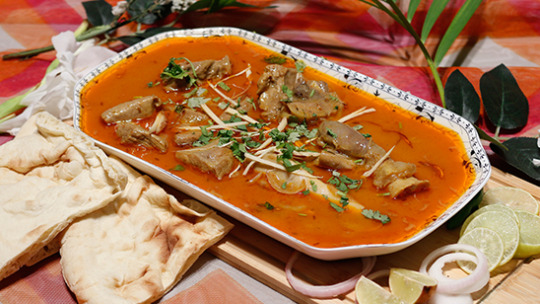
The word Nihari is derived from the Arabic word Nihar, which means morning. Hence the name Nihari means that it was used for breakfast.
Nihari-making originated either in the back streets of Delhi's Jama mosque, or many Lucknow enthusiasts believe it began with the fall of the Mughal Empire in the late 18th century. After, the Nawab happened from the kitchens of Oudh.
The method of preparing nihari is still more or less the same as it was in the early days.
In those days, after the lid of the pot was covered, a dough stick was placed on its sides to maintain maximum temperature and slow cooking with steam. After lightly frying the meat, aromatic spices were added to it and left to slowly decompose and absorb the aroma of these spices.
The flavor of these spices would settle into the meat very gently, as if someone were casting a spell to entice someone.
Making Pakistani Nihar: The Easy Way
Prepare to embark on a culinary voyage, we will try to uncover the secrets of nihari, a dish steeped in tradition and bursting with flavor.
Join us as we delve into the depths of this iconic dish, and unveil a traditional Pakistani nihari recipe that will transport your taste buds to the bustling streets of Lahore or Karachi.
Making The Best Nihari - Ingredients
Before we begin our culinary adventure, let's gather the following ingredients for our nihari:
1 kg beef shank or mutton, cut into chunks
2 large onions, thinly sliced
1/2 cup ghee or cooking oil
3 tablespoons ginger paste
3 tablespoons garlic paste
1 tablespoon turmeric powder
2 tablespoons red chili powder
2 tablespoons coriander powder
1 tablespoon cumin powder
1 teaspoon fennel seeds
1 teaspoon black peppercorns
4-5 green cardamom pods
2-3 cloves
3-4 bay leaves
Salt to taste
Warm water
Fresh ginger slices
Fresh green chilies
Chopped coriander for garnish
Naan bread or steamed rice for serving
Step-by-Step Instructions For Making Nihari
Now, let's dive into the art of preparing Pakistani nihari with our step-by-step guide:
Step 1: Fry the Onions
Heat ghee or cooking oil in a large pot over medium heat.
Add the thinly sliced onions and cook until they turn golden brown and caramelized, stirring occasionally to ensure even cooking.
Step 2: Searing The Meat
Once the onions are caramelized, add the beef or mutton chunks to the pot.
Increase the heat to medium-high and sear the meat on all sides until it develops a rich, brown crust, locking in the flavors.
Step 3: Crafting The Spice Blend
While the meat is searing, prepare the spice blend by combining ginger paste, garlic paste, turmeric powder, red chili powder, coriander powder, cumin powder, fennel seeds, black peppercorns, green cardamom pods, cloves, and bay leaves in a small bowl.
Step 4: Infusing The Flavors
Once the meat is seared to perfection, add the prepared spice blend to the pot.
Stir well to coat the meat evenly with the aromatic spices, allowing them to release their flavors and aromas.
Step 5: Slow Cooking
Pour enough warm water into the pot to cover the meat completely.
Reduce the heat to low, cover the pot with a lid, and let the nihari simmer gently for 4-5 hours, or until the meat is tender and falls apart easily.
Step 6: Thickening The Gravy
After the nihari has simmered for several hours, remove a ladleful of the gravy from the pot and transfer it to a separate bowl.
Using a fork or whisk, mash the onions and spices in the gravy until they form a smooth paste.
Pour the mashed gravy back into the pot and stir well to thicken the nihari to your desired consistency.
Step 7: Serving
Serve the hot nihari in bowls, garnished with fresh ginger slices, green chilies, and chopped coriander.
Accompany the nihari with warm naan bread or steamed rice for a complete and satisfying meal.
The Bottom Line
With its tantalizing aroma and robust flavors, Pakistani nihari is a dish that embodies the essence of Pakistani cuisine. By following this above traditional recipe and savoring each step of the cooking process, you can experience the true magic of nihari and transport yourself to the vibrant streets and bustling bazaars of Pakistan.
So gather your ingredients, unleash your culinary prowess, and treat yourself to a taste of authentic Pakistani nihari that will leave you craving more.
3 notes
·
View notes
Text
The Forgotten Hero: How Russia Helped Launch The Decolonial Movement in The Heart of The British Empire
Rafiq Ahmed, Who Founded the Communist Party of India in Tashkent, Gave His Descendants Both a Legacy and a Name, But Hardly Any of Them Know Why They Are Called ’Roosis’
— December 5, 2023 | RT

Rafiq ‘Roosi’ Ahmed died four decades ago, but his visits to the erstwhile Union of Soviet Socialist Republics (USSR) are forgotten, to the extent that his descendants, who continue to be known as the ‘Roosis’ (Hindi/Urdu for Russian national) of Bhopal, are unsure of the origin of the name they carry, and are ignorant of his illustrious legacy.
After battling lung cancer for three years, Comrade ‘Roosi’ died as quietly as he had lived, in the central Indian city of Bhopal at the age of 93, in 1982.
Bhopal had been run by the Nawabs during British rule, from 1818 to 1947, after which it became part of the Indian Union; since then, the socio-political fabric of the city has changed radically. Roosi’s travels to the USSR in 1920, inspired by the great revolutionary upsurge in Russia and Central Asia, have largely been forgotten.
Rafiq Ahmed's ancestral home is a stone’s throw from the picturesque Upper Lake in a typically non-descript narrow bylane in the old quarters of Bhopal, but it is easy to find – thanks to the title, Roosi. Apart from a handful of senior residents of the city, nobody quite knows the origin of this name.
His daughter-in-law Saulat has done a fine job of keeping his belongings safe – especially those pertaining to his trip to the Soviet Union in September-October 1967 to attend the 50th anniversary of the Great October Socialist Revolution – but the family’s collective knowledge is limited to his second trip to Russia, and some anecdotes from his first visit which border on the mythical.
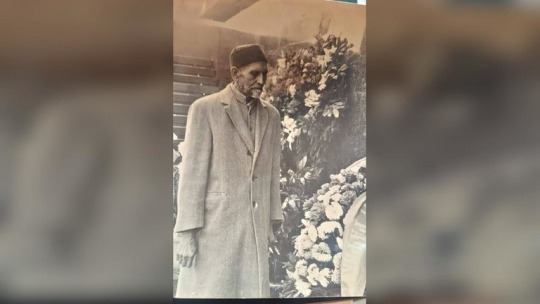
Comrade Rafiq Ahmad, personal archive © RT
They are unaware that Roosi was among the first group of Indian revolutionaries who went to the Soviet Union to seek advice on ousting their British colonial rulers, or that he was among the first to enroll at the Indian Military Training School in Tashkent, or was the founding member of the Communist Party of India in Tashkent, or was tried and jailed for almost a year in the Peshawar Conspiracy Case.
Septuagenarian Khalid Ghani, who knows Bhopal’s history and its people like the back of his hand, attributes this to Roosi’s modest lifestyle. The Ghanis and his family have been neighbors and go back a long way. Ghani’s family used to run a sports shop on the ground floor, and Roosi’s son ran a small hotel called ‘Moonlight’ on the first floor of the same building.
When Ahmed came back from Russia in 1923, people started calling him ‘Roosi’. “He had rubbed shoulders with the top Indian and Russian revolutionaries there, risked his life, and had been jailed. But he didn’t speak about it to anyone, let alone brag about his stay there. Even after the independence of India, he did not list himself as a freedom fighter and avail benefits – such as seeking a plot of land – and secure his future. He just went back to being the person he was before he had left Bhopal. This says a lot about the kind of man he was,” says Ghani.
Modest Background
Roosi hailed from a modest background, and when he returned from Russia, he took a job as the head of the kitchen of the last ruler of Bhopal, Nawab Hameedullah Khan. Much later, when his son Jameel opened his own restaurant, Roosi started assisting him.
Jameel’s wife, Saulat, and his sister, Rafia-un-Nisa, are the two surviving members of the family who spent time with Roosi. Rafia-un-Nisa is in her late eighties and can barely speak. Saulat married into the family in 1969, five decades after Roosi returned from Russia.
Although she is alert and can recall most details about her father-in-law, she is unable to piece together the sequence of events of his life before she married into the family.
“He would be at the hotel during the day and spend the nights writing. I saw him do that for eight years. It is unfortunate that we cannot find most of his writings,” she laments. She pulls out a newspaper clipping to show that Roosi was among the first Indians to write a book on Vladimir Lenin in 1923. However, she has no idea where the book is.

Comrade Rafiq Ahmad (center) meets with youths of the Soviet Union in the city of Kirov. © Sputnik/I. Agranovskiy
Trip to Russia
Roosi’s long period of anonymity ended quite suddenly when Soviet Land magazine published an article on him in around 1966-1967. He was invited to the Soviet embassy in New Delhi and before he knew it, he was on his way to Moscow.
In between, there were mentions of him in the writings of fellow compatriots such as Shaukat Usmani, but they seem to have gone unnoticed.
Ghani recalls, “Nearly five decades after he had returned from Russia, Ahmed was invited to meet the Soviet ambassador in New Delhi. In 1967, he flew to Russia to take part in the 50th anniversary of the Great October Socialist Revolution. Later in 1972, he was acknowledged as a freedom fighter at former prime minister Indira Gandhi’s behest.”
In Moscow, he was awarded a gold medal for his struggle alongside Russian revolutionaries. After receiving the medal, he told Patriot newspaper that the revolutionaries who languished in jail and died there deserved the decoration more than him.
“Twenty of my comrades died fighting there. They were all courageous people…I think they deserved this honor much more than me,” he said, adding that he was held hostage in Kerki (in modern-day Turkmenistan) for over a month along with 36 other Indians, as well as Russian and Turkmen revolutionaries. He spoke about how the British tortured the revolutionaries.
He visited Lenin’s mausoleum and placed a wreath there. He told the newspaper New Age that he had seen Lenin addressing a meeting once, but he could not meet him in person alongside his Indian comrades as he had fallen ill, and this was his greatest misfortune. New Age newspaper then described him as a tall and energetic man.
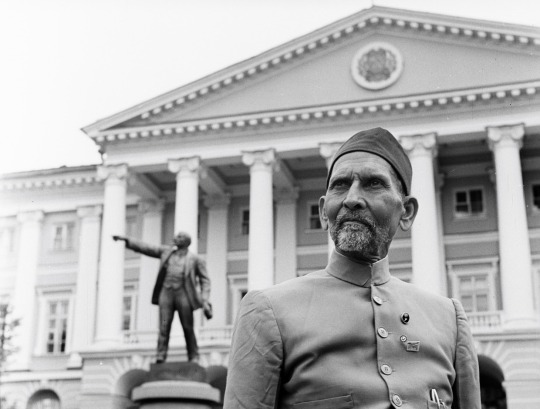
Comrade Rafiq Ahmad with a monument of Vladimir Lenin at Smolny, in Leningrad (N ow St. Petersburg). Ahmad met Lenin in 1921. © Sputnik/Mikhail Ozerskiy
Roosi reunited with other revolutionaries in Moscow; among them was Maria Fortus. She had been his teacher at the Communist University of the Toilers of the East, in Moscow, and remembered all her Indian students by their names. She recognized Roosi and asked him about the other Indian revolutionaries. He also met Avanes Baratov, an old Communist who had participated in the struggle against the counter-revolutionary bands.
Roosi, who was hosted by APN Board (Novosti Press Agency), visited Kerki, where he had fought alongside the Red Army, and Tashkent, where he went to a school where children were taught Urdu. Saulat has a couple of photos of him with Fortus and Baratov, and of his visits to Tashkent and Kerki.
Later that year, he was decorated with another medal by the Soviet Ambassador to New Delhi, N.M. Pegov.
In 1972, he was among the few freedom fighters to be invited to New Delhi by the government of India to celebrate the silver jubilee of India’s Independence.
Roosi’s Journey
A few years after his death, a portion of Roosi’s missing memoir was published in Qazi Wajdi-ul-Hussaini’s book “Barkatullah Bhopali” in 1986.
According to Hussani, when the Khilafat Movement was in full swing in 1920, the Khilafat Committee of Delhi announced a conference and an emotionally charged and rather naïve group of Bhopalis headed for Delhi, believing that this was a call to rid India of the British.
Apart from Roosi, the fiery group included Aftab Ali Khan, Mohammed Ali, Abdul Hayi, Master Mashkoor, Mohammed Khan, Ahmed Kabeer Ahmed, Mohammed Shafi and Mohammed Akhtar.
These revolutionaries stood out among the others when they literally kicked a spy out from their group, and stopped the Imam of Delhi’s Jama Masjid from leading the prayers, as he was said to be close to the British.

Comrade Rafiq Ahmad visiting USSR © RT
However, when they learnt that this was a call to protest against the British stance towards the Turkish Caliphate, a few of Roosi’s companions decided to return to Bhopal. The rest decided to go ahead with the “Hijrat” (Migration), impressed by the enthusiastic call given by Afghanistan’s King Amanullah Khan, and set out for Kabul.
They crossed the border from Peshawar and entered Afghanistan, and headed towards Kabul via Jalalabad. They met King Amanullah Khan, who received them well, but ordered that the refugees be sent to Jabal al-Siraj (a former palace he used as a military base). When the Emir promised to give them jobs, it dawned on the group that he was buying time to strike a deal with the British.
Disappointed, the group escaped from Jabal al-Siraj, covering 30 to 40 miles on foot each day, crossing difficult mountains and treacherous deserts, and reached the Turkistan border, and then finally Termez via Mazar-i-Sharif and Ghor. In Termez, they heard the fiery speech of a Russian commander who said his country had opened its doors to the workers of the world. They met the commander and went to Tashkent with his help.
In ‘The Indian Revolutionaries and the Bolsheviks - their early contacts, 1918-1922’, Arun Coomer Bose writes, “We have it on the authority of Rafiq Ahmed (Roosi) that the first four ‘muhajirs’ (Migrants), including himself, reached Kabul sometime in May 1920. They were well received, and were lodged at Jabal us-Siraz (Jabal al-Siraj), at some distance from Kabul. Others, who came after them, were also brought there, and by the beginning of July there were about a couple of hundred of them at Jabal us-Siraz (Jabal al-Siraj).”
After the founding of the Communist Party of India in Tashkent, it was decided that some of the Indian ‘Muhajirs’ would return to India to establish the foundations of a communist movement there.
Accordingly, towards the end of March 1922, a bigger group of ten, which included Roosi, set out for India via the Pamir route, writes Bose. “At Kharog they divided themselves into small groups and, barring a couple of them, succeeded in reaching Chitral or the tribal territories in the north-west of India. But, almost all of them were apprehended by the Indian police, and were tried in the Peshawar Conspiracy Case,” adds Bose.
Roosi was jailed for nearly a year. A letter issued by the Government of India on December 25, 1972 states that Roosi was arrested in the Peshawar Conspiracy Case (Crown vs Akbar Shah and seven others in the Moscow Tashkent conspiracy case) in the last week of October 1922 and released on May 18, 1923, and that he spent his term in the District Jail in Peshawar.
Saulat’s son now runs the family restaurant, which serves Mughlai cuisine. Her daughter, Bushra, who was eight years old when Roosi passed away, has taken charge of her grandfather’s papers and plans to preserve them.
The next generation of Roosis are unaware of their great-grandfather’s lineage, content with the knowledge that he visited Russia. Can, then, one blame the rest of Bhopal?
— By Lamat R Hasan, an Independent Journalist Based in Delhi
#Feature#Rafiq Ahmed#Rafiq ‘Roosi’ Ahmed#Union of Soviet Socialist Republics (USSR)#Hindi/Urdu for Russian National#Bhopal | India 🇮🇳#Russia 🇷🇺#British 🇬🇧 Empire#“Hijrat” (Migration)#Tashkent | Capital of Uzbekistan 🇺🇿 Now#Peshawar (Now City of Pakistan 🇵🇰)#Kabul | Jalalabad | Afghanistan 🇦🇫#King Amanullah Khan#Indian Revolutionaries & Bolsheviks#Turkistan#Termez | Mazar-i-Sharif | Ghor#Kabul#Muhajirs#Mughlai Cuisine
2 notes
·
View notes
Text
Spices of Bengal: Discover the Flavors of Bong Biryani
Bengal, with its rich cultural heritage and exquisite culinary traditions, has gifted the world with many unforgettable dishes. Among the most cherished is the iconic Bong Biryani, a fragrant, spiced rice dish that has transcended generations. It is a blend of rich history, tender meats, and aromatic spices that come together to create a truly unique and unforgettable experience. Let’s delve into the heart of Bong Biryani, explore its origins, and uncover what makes it a beloved dish across the world.
The Origins of Bong Biryani: A Fusion of Cultures
The origins of Bong Biryani are rooted in the royal kitchens of Bengal, where it was shaped by the culinary influences of Mughal rule in the 19th century. During the reign of the Nawabs of Bengal, the region was introduced to Mughal cooking techniques, which led to the evolution of what we now know as Bengali Biryani.
Unlike other regional variations of biryani, the Bengali version incorporates unique elements that distinguish it from the rest. Most notably, it features the use of potatoes, a key ingredient that is not found in many other biryanis, and the inclusion of mustard oil in the cooking process, which imparts a distinctive flavor.
Over time, Bong Biryani evolved, incorporating local ingredients and cooking methods, resulting in a dish that represents a perfect harmony of tradition and innovation.
The Key Ingredients: A Symphony of Spices
The magic of Bong Biryani lies in its intricate balance of spices and flavors. Here’s a look at the key ingredients that give Bong Biryani its signature taste:
Ghee (Clarified Butter): Essential for achieving the rich, indulgent taste, ghee forms the base of the biryani’s cooking process, adding both flavor and fragrance to the dish.
Bengali Spices: A blend of whole spices like cinnamon, cardamom, cloves, and bay leaves forms the aromatic base of Bong Biryani. These spices combine to create the signature fragrance that fills the air when the biryani is served.
Saffron & Rose Water: The addition of saffron gives the biryani its golden color, while rose water adds a delicate floral note, enhancing the dish’s aroma and flavor.
Potatoes and Meat: One of the most defining characteristics of Bong Biryani is the inclusion of potatoes, which are cooked to perfection and absorb the rich flavors of the biryani. The meat—usually chicken, mutton, or beef—is marinated in yogurt and a blend of spices, ensuring tenderness and deep flavor.
Basmati Rice: The choice of basmati rice is critical for Bong Biryani. Its long grains remain fluffy and separated, absorbing the flavor-packed gravy and spices without becoming soggy.
The Cooking Process: A Labor of Patience
The preparation of Bong Biryani is a careful, slow-cooked process that requires attention to detail. The first step is marinating the meat, which is seasoned with a mixture of yogurt, ginger, garlic, and a selection of spices. The longer the marination, the more flavorful the meat becomes.
Next, the rice is partially cooked and then layered with the marinated meat in a pot. The final step is dum cooking, where the pot is sealed with dough, trapping the steam and allowing the flavors to meld. This slow-cooking method helps retain the moisture and aroma of the spices, ensuring that the meat remains juicy and the rice perfectly tender.
The Bong Biryani Experience: A Journey for the Senses
What sets Bong Biryani apart is not just its ingredients but the experience of savoring it. The dish is traditionally served with a side of raita (a yogurt-based salad) and boiled eggs, which balance the rich flavors of the biryani. The first bite is always the most memorable—an explosion of flavors, with the spice of the meat, the creaminess of the ghee, and the fragrance of saffron all coming together in harmony.
Whether enjoyed at a family gathering, a wedding feast, or a bustling restaurant in Kolkata, Bong Biryani brings people together. Its ability to comfort and satisfy is what makes it so special. The inclusion of potatoes, which absorb the biryani's spices, provides a unique twist that keeps people coming back for more.
Bong Biryani: A Global Culinary Delight
Though its roots are in Kolkata, Bong Biryani has gained international acclaim. Food lovers from around the world now flock to the city to experience its authentic taste. In fact, the dish has become so popular that several restaurants around the world serve their own version, adding local ingredients and techniques to make it their own.
No matter where it is enjoyed, Bong Biryani continues to captivate the hearts of those who experience it. Its rich heritage, unmatched flavor, and the sheer pleasure it brings to the palate have cemented its place in the culinary world as a dish worth celebrating.
Conclusion: A Dish with Timeless Appeal
Bong Biryani is more than just a meal—it's an experience that brings together history, culture, and flavor in one bowl. Whether you’re enjoying it for the first time or have been a lifelong fan, each bite tells the story of Bengal’s rich culinary traditions. From the spices to the technique, Bong Biryani continues to be a beloved dish that transcends borders, bringing the rich flavors of Bengal to food enthusiasts worldwide.
Follow Us- https://www.instagram.com/bongbiryanii/
1 note
·
View note
Text
From Biryani to Kebabs: Food Trails in Lucknow

Lucknow, the capital of Uttar Pradesh, is not just known for its historical monuments and rich culture; it is also celebrated for its exquisite culinary scene. The city is a melting pot of flavors, where Mughlai influences blend seamlessly with local traditions. From the tantalizing aroma of biryani wafting through the streets to the sizzle of kebabs being grilled in open kitchens, Lucknow offers a gastronomic adventure that every food lover must experience. For those eager to explore this culinary treasure, a Lucknow tour and travel experience can enhance the journey, especially when guided by a reliable travel agency in Lucknow.
The Essence of Awadhi Cuisine
Awadhi cuisine, originating from the royal kitchens of Lucknow, is renowned for its slow-cooked dishes, aromatic spices, and rich flavors. It reflects a history of culinary excellence that dates back centuries. The use of techniques like “dum” (slow cooking) and “kebabi” methods showcase the artistry involved in creating each dish. As you embark on a food trail in Lucknow, you'll discover that each bite tells a story of heritage and tradition.
1. Lucknow's Famous Biryani
No exploration of Lucknow’s food scene is complete without indulging in its famous biryani. Lucknowi biryani is distinct from other varieties, featuring fragrant basmati rice cooked with marinated meat, saffron, and a blend of spices. The most famous establishments to try biryani include:
Tunday Kababi:
Famous for its mutton biryani, this iconic eatery has been serving delicious food for decades. The tender meat and perfectly cooked rice make it a must-try.
Biryani Mahal:
Known for its flavorful biryani, Biryani Mahal attracts both locals and tourists. Their secret spice blend sets it apart.
2. The Kebab Culture
Kebabs are another highlight of Lucknow’s culinary landscape. The city offers a variety of kebabs, each prepared with unique spices and cooking methods. Some popular kebab types to try include:
Galouti Kebab:
Known for its melt-in-the-mouth texture, Galouti kebabs are made from finely minced meat mixed with a blend of spices and cooked on a griddle. A visit to Maqbool's Kebab is essential for an authentic experience.
Seekh Kebab:
These are skewered kebabs made from spiced minced meat. Kebabiya is a popular spot to sample delicious seekh kebabs, grilled to perfection.
3. Chaat: A Street Food Delight
Lucknow is also famous for its vibrant street food scene, with chaat being a beloved favorite among locals. This tangy and spicy snack is made from a combination of potatoes, chickpeas, yogurt, and a variety of chutneys. Some must-try spots include:
Baba Thandai:
Known for its unique chaat preparations, this place serves a delightful version that keeps customers coming back for more.
Royal Chaat Bhandar:
A favorite among locals, their dahi puri and aloo chaat are highly recommended for a burst of flavors.
4. The Sweet Finale
No food trail in Lucknow would be complete without indulging in some delectable sweets. The city is known for its rich desserts, which provide a perfect ending to your meal. Here are a couple of popular sweets to try:
Kulfi:
Lucknow’s version of this traditional ice cream is rich and creamy. You can find vendors selling various flavors throughout the city, especially during the summer months.
Gulab Jamun:
Soft and syrupy, these sweet balls are a staple at any local sweet shop. Nawab’s Sweet House is a renowned place to sample this delight.
The Role of Travel Agencies
While navigating through the culinary landscape of Lucknow can be exciting, it can also be overwhelming due to the multitude of choices available. This is where a travel agency in Lucknow can make your experience smoother and more enjoyable. Here are some ways a travel agency can enhance your food trail:
Expert Guidance
Travel agencies often have knowledgeable guides who are well-versed in the local cuisine. They can take you to hidden gems that you might otherwise miss, offering insights into the history and preparation of various dishes.
Customized Food Tours
Many travel agencies offer customized food tours that cater to your preferences. Whether you want to focus on street food, traditional dishes, or a combination of both, they can tailor an itinerary that suits your taste buds.
Convenience and Safety
Exploring a new city can be daunting, especially when it comes to transportation and safety. A travel agency can arrange for transportation, ensuring you have a reliable way to get around while focusing on the food.
Conclusion
Lucknow is a paradise for food enthusiasts, offering a rich tapestry of flavors and culinary experiences. From the iconic biryani to succulent kebabs and delightful sweets, the city's food scene is a journey worth savoring. Whether you're a local or a visitor, exploring these culinary delights through a well-planned Lucknow tour and travel experience can elevate your appreciation for Awadhi cuisine. Engaging a reputable travel agency in Lucknow can help you navigate this gastronomic landscape, ensuring that your culinary adventure is not just satisfying but unforgettable. So pack your bags and prepare your taste buds for a journey through the flavors of Lucknow!
0 notes
Text
A Food Lover’s Guide to Lucknow: Must-Try Awadhi Cuisine
Lucknow, the capital city of Uttar Pradesh, is a paradise for food lovers. Known as the City of Nawabs, Lucknow boasts a rich culinary heritage that has evolved over centuries. The city's cuisine, particularly the Awadhi style of cooking, is famous across the world. Awadhi cuisine is characterized by its slow-cooking techniques, intricate spice blends, and the use of fragrant ingredients. If you’re visiting Lucknow, indulging in its culinary delights is a must. This guide will take you through the must-try Awadhi dishes and where you can enjoy them.
The Essence of Awadhi Cuisine
Awadhi cuisine is deeply rooted in the royal kitchens of the Mughal era. It has been influenced by Persian, Central Asian, and Mughal cooking styles, which were later perfected by the khansamas (royal chefs) of Awadh. The cuisine is renowned for its kebabs, biryanis, kormas, and rich gravies, often cooked using the dum method—slow-cooking in a sealed pot to preserve the aroma and flavors.
Must-Try Awadhi Dishes in Lucknow
Galouti Kebab
Perhaps the most famous dish in Lucknow, Galouti Kebabs was created for a Nawab who had lost his teeth but didn’t want to give up his love for kebabs. These melt-in-the-mouth kebabs are made from finely minced meat, marinated with spices, and cooked to perfection.
Tunday Kababi
Tunday Kababi is a household name in Lucknow. This delicacy is known for its unique blend of over 160 spices, creating a flavor explosion in every bite. Served with soft, flaky parathas, it’s a dish that every food lover must try.
Lucknawi Biryani
Unlike the spicier versions from Hyderabad or Kolkata, Lucknawi Biryani is subtle and aromatic. The rice is cooked with delicate spices, and layers of marinated meat are added to create a fragrant, flavorful dish that is light yet rich.
Kakori Kebab
Another iconic kebab from Lucknow, Kakori Kebab is known for its smooth texture and rich taste. The meat is finely minced and blended with a mix of spices and dried fruits, then grilled to perfection.
Nihari
A popular breakfast dish in Lucknow, Nihari is a slow-cooked stew made with beef or lamb, simmered overnight with spices. It’s traditionally served with naan or kulcha and is a perfect example of the dum style of cooking.
Sheermal
Sheermal is a mildly sweet, saffron-flavored bread that pairs beautifully with rich gravies like Nihari or Korma. It’s soft, flaky, and a perfect accompaniment to the robust flavors of Awadhi dishes.
Kulfi Falooda
No meal in Lucknow is complete without a sweet treat, and Kulfi Falooda is a local favorite. This rich, creamy dessert is made from condensed milk, flavored with saffron and cardamom, and topped with vermicelli and rose syrup.
Paya
Paya, or trotters, is a dish made from lamb or beef trotters cooked slowly in a rich, spicy gravy. It’s often enjoyed with naan or rumali roti and is known for its deep, robust flavors.
Where to Savor Awadhi Cuisine in Lucknow
When it comes to enjoying these culinary delights, Lucknow offers a wide range of options from street food vendors to fine dining restaurants. However, if you are looking for a comfortable and authentic dining experience, Qmin at Ginger Lucknow is an excellent choice. Located conveniently in the heart of the city, Qmin offers a curated menu that showcases the best of Awadhi cuisine, prepared by skilled chefs who understand the nuances of traditional cooking.
Qmin at Ginger Lucknow provides an elegant dining environment where you can enjoy the flavors of Lucknow in comfort. Whether you are craving a plate of Galouti Kebabs, a fragrant serving of Lucknawi Biryani, or the rich taste of Nihari, Qmin offers a delightful experience that stays true to the city’s culinary roots.
Where to Stay in Lucknow
While food might be the highlight of your visit to Lucknow, having a comfortable place to stay is equally important. For those looking for a hotel in Lucknow near Charbagh, Ginger Lucknow offers the perfect blend of comfort and convenience. Located close to major tourist attractions and business centers, Ginger Lucknow provides modern amenities and a cozy environment for travelers.
Whether you’re in Lucknow for business or leisure, Ginger Lucknow offers everything you need for a pleasant stay. The hotel’s proximity to Charbagh Railway Station makes it an ideal choice for travelers looking for easy access to transportation. With well-appointed rooms, attentive service, and a welcoming atmosphere, Ginger Lucknow ensures that your stay in the City of Nawabs is both comfortable and memorable.
Conclusion
Lucknow’s rich culinary heritage is a treasure trove for food lovers. The city’s Awadhi cuisine offers a unique blend of flavors and techniques that have been perfected over centuries. From the melt-in-the-mouth Galouti Kebabs to the fragrant Lucknawi Biryani, each dish tells a story of the city’s royal past and cultural diversity. As you explore the culinary delights of Lucknow, make sure to dine at Qmin at Ginger Lucknow for an authentic experience that captures the essence of Awadhi cuisine.
And when it comes to accommodation, Ginger Lucknow provides a comfortable and convenient base for your stay in the city. Whether you’re looking for a hotel in Lucknow near Charbagh or simply want to enjoy a meal at one of the famous restaurants in Lucknow, Ginger Lucknow is the perfect choice for a memorable and satisfying visit to the City of Nawabs.
0 notes
Text
Spacious 3 BHK Flats in Lucknow: Your Dream Home Awaits
Lucknow, the city of Nawabs, is known for its rich cultural heritage, warmth, and charm. In recent years, it has also emerged as a thriving hub for modern living with a blend of traditional elegance and contemporary comforts. If you are searching for a perfect home in this growing city, a spacious 3 BHK flat might just be what you need. Offering ample space, privacy, and the flexibility to cater to growing family needs, these flats provide an ideal balance for comfortable living. Here’s why investing in a 3 BHK flat in Lucknow could be the key to unlocking your dream home.
The Allure of a 3 BHK Home
One of the main attractions of a 3 BHK flat is the generous space it provides. With three bedrooms, a living room, a kitchen, and often a balcony or two, these homes are designed to accommodate families without feeling cramped. Whether you need a dedicated workspace, a guest room, or extra storage, the flexibility of a 3 BHK layout ensures that your home can grow with your needs.
For those with children, a 3 BHK flat offers each family member their own space while still providing common areas for family time. For couples or singles, the extra rooms can serve as a home office, hobby space, or guest room, adding to the versatility of the property.

Modern Amenities and Luxurious Living
The new wave of 3 BHK flats in Lucknow comes equipped with state-of-the-art amenities designed for modern lifestyles. From 24/7 security, power backup, and parking spaces to clubhouses, gyms, and landscaped gardens, these residential complexes are built with comfort and convenience in mind. Many also offer additional perks like swimming pools, sports facilities, and children’s play areas, ensuring that residents can enjoy a well-rounded lifestyle within the community.
The interiors of these flats are often crafted with meticulous attention to detail. Spacious rooms, high-quality fittings, modular kitchens, and elegant finishes make these homes a joy to live in. Additionally, many projects offer customization options, allowing you to personalize your space according to your taste and preferences.
Strategic Locations for Every Lifestyle
Whether you prefer the buzz of city life or the peace of suburban living, Lucknow’s real estate market has options that cater to all preferences. Many of the city’s leading residential developments are strategically located near schools, hospitals, shopping centers, and business hubs, ensuring that everything you need is within reach. Areas like Gomti Nagar, Shaheed Path, and Alambagh are particularly popular for 3 BHK flats due to their excellent connectivity, infrastructure, and neighborhood amenities.
For those who prioritize accessibility, 3 BHK flats near major roads and transportation hubs offer hassle-free commutes to key parts of the city. On the other hand, if tranquility is your priority, Lucknow also has serene residential areas with lush greenery and peaceful surroundings, providing the perfect escape from the hustle and bustle of urban life.
An Investment That Grows with You
Investing in a spacious 3 BHK flat in Lucknow isn’t just about upgrading your lifestyle; it’s also a smart financial decision. The city’s real estate market has been consistently growing, making property purchases here a sound long-term investment. Whether you plan to live in the flat or rent it out, the demand for well-located, spacious homes is always high, ensuring steady returns.
Moreover, with Lucknow’s expanding infrastructure and the government’s focus on development projects, property values are likely to appreciate over time. A 3 BHK flat is also future-proof in terms of space and functionality, ensuring that your investment remains relevant as your family’s needs evolve.
Conclusion: Your Dream Home in Lucknow Awaits
The search for a dream home in Lucknow ends with spacious 3 BHK flats that perfectly balance style, space, and convenience. Whether you’re a young family, a professional couple, or someone planning to upgrade your lifestyle, these homes offer the room, luxury, and comfort you desire. With a wide range of options available in prime locations, you’re sure to find the perfect 3 BHK flat that suits your lifestyle and aspirations.
So why wait? Explore the options, visit the sites, and take the first step towards owning a beautiful and spacious 3 BHK flat in Lucknow—a home that not only meets your needs today but also stands ready to grow with you in the future. Your dream home is closer than you think!
0 notes
Text
Best North Indian Breakfast for Diabetes
This article is originally published on Freedom from Diabetes website, available here. North Indian Include various regions like, Haryana, Bihar, Jammu & Kashmir, Punjab, Himachal Pradehs and Uttar Pradesh. These regions has collection of recipes. From these recipe we have special collection of diabetic friendly recipes. So diabetic peoples can eat with without worry.




Dahi vada: This is the popular food item from the north india. It consists of fried lentil dumplings that are dunked in yogurt. This is then garnished with coriander and spicy tamarind chutney. This FFD style Dahi Vada recipe, as we use vegan curd in it. The tamarind chutney is made using dates and not sugar. We have not use sugar here.
Rajma Tikki This is a beautiful North Indian Breakfast recipe. These tikkis are prepared from kidney beans (rajma), boiled potatoes, crushed bread, and spices. FFD style rajma Tikki includes useful seeds like Magaz and almond milk both of which are a good addition. Cutting the potatoes from it reduces the carb content too.
Galauti Kebab This kebab originated in Lucknowi Nawab's kitchen. Galauti means 'the thing that melts in the mouth". They are prepared from minced mutton a non-vegetarian dish. But here we are going to prepare a completely vegan dish made up of black chickpeas.
Besan Chilla This is a popular pancake from North India that is prepared and made from Bengal gram flour. It is not only healthy and tasty but simple to prepare.
Stuffed Puri Puri can also be called an Indian flatbread that is paired with different types of curries. It can be made by stuffing it too. Stuffed puri is a great breakfast option. FFD suggests the usage of emmer wheat flour to make it more healthy. We also suggest shallow frying to reduce the oil content.
These breakfast item's recipes are here, please go through this Link. Healthy Eating, Happy Living! Also please connect with me on my website, Facebook page, and YouTube if you want to stay in touch or give me any feedback!
#North indian breakfast#North indian breakfast for diabetes#diabetic friendly North Indian breakfast#Healthy breakfast recipes#Nutritious breakfast ideas#Easy healthy breakfast#Healthy morning meals#Best healthy breakfast options#Delicious healthy breakfast#Breakfast for happy living
0 notes
Text
3 BHK Flats in Lucknow
Introduction
Lucknow, the city of Nawabs, is renowned for its rich history, vibrant culture, and architectural marvels. Over the years, it has evolved into a bustling urban hub, attracting people from all walks of life. One of the most sought-after residential options in this growing city is the 3 BHK flat. In this article, we will explore why 3 BHK flats in Lucknow are in high demand, the prime locations to consider, and what makes them the ideal choice for families.

Why Choose a 3 BHK Flat in Lucknow?
1. Ample Space for Families
A 3 BHK flat typically offers three bedrooms, a hall, and a kitchen, providing ample space for families. This configuration is perfect for nuclear families, those with growing children, or even extended families who require extra space for guests. The additional room can serve various purposes such as a home office, study room, or play area for kids.
Why Choose a 3 BHK Flat in Lucknow?
1. Ample Space for Families
A 3 BHK flat typically offers three bedrooms, a hall, and a kitchen, providing ample space for families. This configuration is perfect for nuclear families, those with growing children, or even extended families who require extra space for guests. The additional room can serve various purposes such as a home office, study room, or play area for kids.
2. Affordability and Value for Money
Compared to metropolitan cities like Delhi or Mumbai, Lucknow offers 3 BHK flats Lucknow at more affordable prices without compromising on the quality of living. The cost-effectiveness makes it an attractive option for middle-class families looking to invest in real estate. Additionally, the steady appreciation in property values in Lucknow ensures a good return on investment.
0 notes
Text
Discover the Charm of Homestays in Lucknow

Experience Local Hospitality
Imagine waking up to the aroma of freshly brewed chai and the sound of birds chirping. You step out to a warm greeting from your host, who is eager to share stories about Lucknow. Staying in homestays in Lucknow is like having a local friend show you around.
Live Like a Local
Homestays offer a unique way to explore Lucknow. Unlike hotels, these stays are nestled in residential areas, giving you a true feel of the city’s rhythm. Your host might take you on a morning walk to a local market or suggest hidden gems for kebabs and biryanis.
Discover Nawabi Charm
The charm of a homestay lies in the little things. Imagine sitting in a cozy living room, sipping tea, and learning about Lucknow’s rich history from someone who has lived it. The stories of Nawabs, the tales of the British era, and the cultural heritage come alive in these conversations.
Traditional Elegance
You'll find the decor in these homes is often traditional, reflecting the elegance of the Nawabi culture. Handcrafted furniture, intricate artwork, and vintage photographs add to the charm. It's like living in a piece of history.
Savor Home-Cooked Delights
One of the best parts? The food. Home-cooked meals prepared with love and care. Your host might even invite you into the kitchen to share family recipes or show you how to make the perfect Lucknowi biryani.
Create Lasting Memories
Staying in a homestay in Lucknow is more than just a place to sleep. It's an experience. It's about making connections, learning the local culture, and creating memories that will last a lifetime. So, the next time you plan a trip to Lucknow, consider a homestay. It's the best way to truly explore the City of Nawabs.
0 notes
Text
Kisan Diwas: Five Farmers You Should Know About

23rd December is annually celebrated as ‘Kisan Diwas’ to honour the 5th Prime Minister of India, Chaudhary Charan Singh. He has been referred to as the Champion of India’s peasants for his contribution toward the upliftment of farmers.
On Kisan Diwas, farmers in India arrange seminars at the divisional, district, and block levels and are educated about the various schemes that have been implemented by the government for their benefit.
To observe Kisan Diwas, we would like to look at five notable farmers who have made significant contributions to the agricultural sector.
Rajkumari Devi

Popularly known as ‘Kisan Chachi’, Rajkumari Devi is a farmer from Muzaffarpur, Bihar, India. She can be seen travelling in a cycle from village to village, educating people about kitchen farming. She also encourages women to be financially independent through farming. She has set up a non-profit organization, Anandpur Jyoti Centre, which employs women to make processed products like jams, jellies, and pickles.
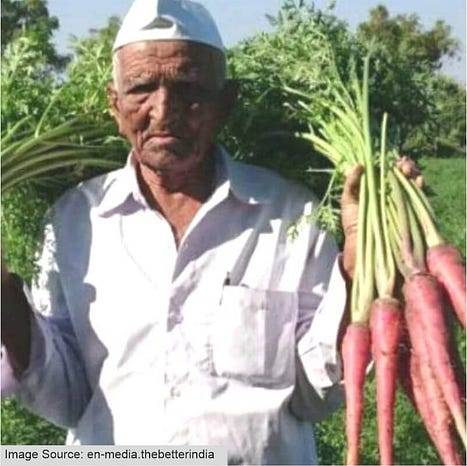
Vallabhbhai Vasrambhai Marvaniya is famous for introducing carrots to the state of Gujarat, as locals did not consider the vegetable fit for consumption back then. He first tasted the vegetable while feeding the cattle. Finding it to be delicious, he decided to grow it and sell it at the age of 13. The business soon boomed. Even Nawab of Junagadh, Muhammad Mahabat Khan III, became his regular customer.

In 2018, Kamala Pujhari was appointed as a board member of the Odisha Planning Board by CM Naveen Patnaik. She was even awarded the Best Farmer Award by the Odisha Government in 2004. This reverence was not unfounded, as Kamala has been credited with preserving over a hundred traditional paddy varieties, along with the endangered breeds of black cumin, sesame, turmeric, maha kanta, phula and ghantia. She also raised her voice against chemical farming, encouraging the villagers to abandon chemicals and engage in organic methods of farming. She got global fame and recognition at an organic farming workshop by the Foundation at Johannesburg in 2002.

Venkateswara Rao Yadlapalli is one of the most innovative farmers in India. He uses modern-day technologies to help farmers adopt organic farming. This includes his recently launched mobile apps on natural and allied farming. He also runs magazines like Rythunestham, Pasunestham and Prakruthi Nestham, that promote natural farming, animal husbandry, and horticulture. He even honours farmers by conducting annual felicitation and award ceremonies to honour the farmers with remarkable achievements.

Ram Saran Verma is known as Uttar Pradesh’s hi-tech farmer. In 1988, he became one of the first farmers in the state to introduce tissue culture for banana farming. He also grew red bananas, which against Rs 15 per kg for the regular variety, were sold at Rs 80–100 per kg. Today, his methods have benefited over 50,000 farmers in his neighbouring districts. He also hosts training sessions and workshops for farmers from within and outside the country.
Filaantro, along with Child Help Foundation, are sympathetic to the downtrodden and tries its best to uplift the poor. 2,147 individuals have benefited from the village development projects.
Thank you for taking the time to read this article. Make sure to share it with all your friends and family members.
#crowdfunding#fundraising#raise funds#charity#filaantro#nonprofits#education#donate#donations#volunteering
0 notes
Text
Babugosha: An Exotic Delight

Title: Babugosha: An Exotic Delight
When it comes to culinary experiences that transport you to distant lands and evoke a sense of adventure, Babugosha is an exotic delight that promises to tantalize your taste buds and ignite your curiosity. This unique dish, a treasure from the heart of India, is a flavorful and comforting masterpiece that brings together a medley of spices, textures, and cultural influences.
Babugosha, also known as "Babu Gosh" or "Babu Gosh ka Kheema," originates from the vibrant and diverse culinary landscape of India. Hailing from the North Indian state of Uttar Pradesh, this dish combines elements from Mughlai and Awadhi cuisine, showcasing a rich history and an amalgamation of flavors.
The star of the show in Babugosha is the humble potato. But in this dish, the potato is transformed into a culinary marvel that even meat lovers would find hard to resist. The recipe begins with a generous helping of small, round baby potatoes. These are parboiled to maintain their firmness and then hollowed out, creating a potato shell ready to be filled with a delectable mixture.
The filling for Babugosha is where the magic truly happens. It consists of ground lamb or mutton, finely minced onions, a blend of aromatic spices, and herbs such as coriander, mint, and green chilies. The spices, which include cumin, coriander, garam masala, and turmeric, provide an enticing depth of flavor while chili peppers infuse the dish with a delightful kick. The mixture is carefully sautéed to ensure all the ingredients meld together seamlessly, creating a spicy, savory, and fragrant filling that is nothing short of extraordinary.
As the filling is prepared, the hollowed-out potato shells are brushed with oil, spices, and a pinch of salt, and then roasted until they become golden and slightly crispy. The potatoes form a perfect vessel to hold the rich and aromatic filling, which is carefully stuffed into each potato shell, creating a tantalizing union of flavors and textures. The end result is a succulent blend of spicy meat encased in the crisp yet tender embrace of the potato.
To enhance the overall experience, Babugosha is often served with an array of accompaniments that elevate the dish to new heights. A dollop of cool and creamy yogurt, a sprinkle of freshly chopped cilantro, and a few slices of zesty lemon are common garnishes, providing a refreshing contrast to the bold flavors of the dish. In addition, a side of naan or fragrant basmati rice is often served to complete the meal.
The history of Babugosha is as rich and diverse as its flavor profile. The dish has its roots in the royal kitchens of Lucknow, a city known for its culinary heritage and the birthplace of many legendary dishes. The influence of Mughlai cuisine is evident in the use of spices and techniques, while the Nawabs of Lucknow added their own touch by focusing on the art of slow cooking and attention to detail.
Babugosha has a special place in the hearts of the people of Uttar Pradesh, and it is often prepared during celebrations, festivals, and special occasions. Its tantalizing aroma and unforgettable taste make it a cherished tradition in many households. The name "Babugosha" is a testament to its popularity and the love it has garnered over generations.
The preparation of Babugosha may seem intricate, but it is well worth the effort. The meticulous process and careful selection of ingredients are a testament to the dedication and passion that go into creating this culinary masterpiece. Whether prepared at home or enjoyed in a traditional Indian restaurant, each bite of Babugosha is a journey that takes your taste buds on a captivating adventure.
In addition to its extraordinary flavor, Babugosha also serves as a symbol of India's rich cultural tapestry. It exemplifies the country's ability to harmoniously blend diverse culinary traditions into a single dish, creating a unique and captivating experience. This is a testament to India's ability to embrace diversity and create something truly remarkable from it.
For those with an adventurous palate or a deep appreciation for authentic Indian cuisine, Babugosha is a must-try. The exotic delight of this dish offers a taste of India's culinary heritage, a journey through centuries of tradition, and a vibrant exploration of flavors. It is a culinary masterpiece that transcends borders and brings the heart of India to your plate.
So, the next time you find yourself yearning for a unique and exotic dining experience, consider Babugosha. This extraordinary dish is a testament to the power of food to transport us to far-off places and immerse us in the beauty of diverse cultures. With each bite, you'll embark on a delightful adventure that will leave a lasting impression on your palate and your memory.
0 notes
Text
Bucket List Indian Restaurants in Kitchener-Waterloo Area
While not as massive as Toronto's, the Kitchener-Waterloo restaurant scene is delightful in its own way. This region boasts diverse dining establishments, each offering a unique culinary experience. Whether you're seeking North Indian delicacies or classic South Indian flavours, you'll find it here. You're in for a treat if you're looking for a fantastic meal close to your location, with delicious food and an inviting ambiance. These Kitchener-Waterloo restaurants check all the boxes!
1. Tandoori Xpress - Waterloo
Tandoori Xpress is a hidden gem for Indian food aficionados. This cozy restaurant offers a medley of traditional and contemporary dishes, each bursting with authentic flavours. From the moment you walk in, the aroma of freshly baked naan and spices wafting through the air sets the stage for a mouthwatering experience.
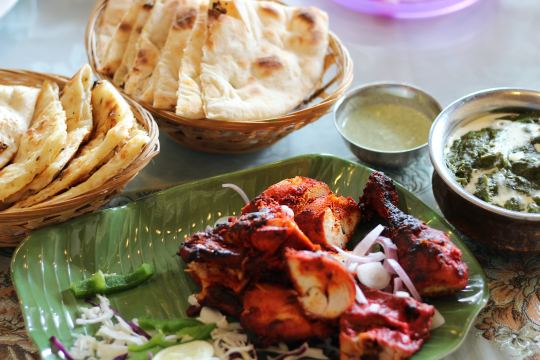
Main Menu Highlights:
Butter Chicken: A creamy tomato-based curry with tender pieces of chicken.
Paneer Tikka: Marinated and grilled cubes of cottage cheese.
Lamb Biryani: Fragrant basmati rice cooked with succulent lamb and aromatic spices.
Mango Lassi: A sweet and refreshing yogurt-based drink.
The Butter Chicken, a universally beloved dish, is a must-try. It's creamy, rich, and beautifully spiced, making it the ultimate comfort food. Pair it with a serving of fragrant Lamb Biryani for a satisfying meal.
Location: 425 University Ave, Waterloo, ON N2K 4C9
Menu Details: onlineordering.mealsy.ca
2. Grand Malabar - Kitchener
If you're a fan of the bold and aromatic flavors of South Indian cuisine, Grand Malabar in Kitchener is your ticket to a culinary adventure. The restaurant specializes in dishes that pack a punch of heat and spice, transporting your taste buds straight to the southern coast of India.
Main Menu Highlights:
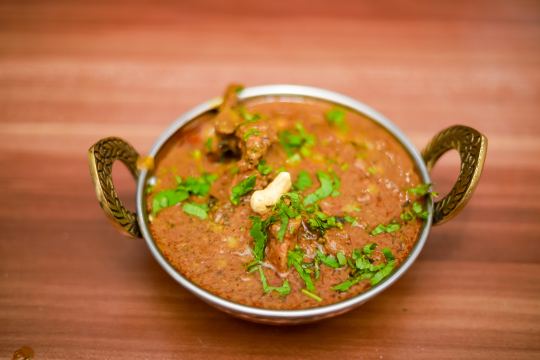
Alleppy Chicken Curry: A flavorful, spicy chicken curry infused with aromatic South Indian spices.
Appam: Light and airy rice pancakes served with a side of coconut milk for dipping.
Kerala Fish Curry: A tangy and spicy fish curry made with coconut milk and tamarind.
The Malabar Chicken Curry is an absolute winner, with its explosive flavours and hearty appeal. Dip your Appam into the delicious curry, and you'll experience a delightful explosion of taste.
Location: 347 Erb St. W #4, Waterloo, ON N2L 1W4
Menu Details: drive.google.com
3. Dosha Twist - Waterloo
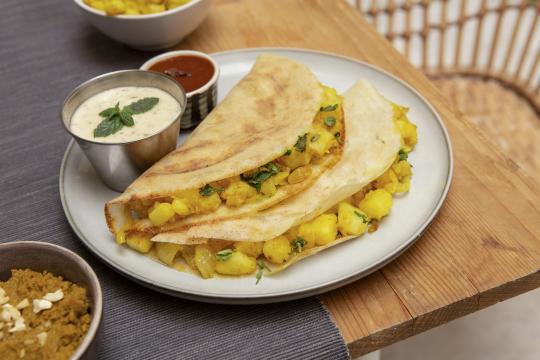
Dosha Twist in Waterloo offers a unique blend of South Indian street food and traditional dishes. If you're in the mood for something different and exciting, this is the place to be. The restaurant's focus on dosas and authentic flavors will take your taste buds on a journey to the bustling streets of Chennai.
Main Menu Highlights:
Masala Dosa: A crispy rice crepe filled with spiced potatoes and served with coconut chutney.
Paneer Butter Masala: A creamy tomato-based curry with chunks of soft, spiced cottage cheese.
Rasam: A tangy, tamarind-based South Indian soup with a blend of spices.
The Masala Dosa is a must-try. It's a crunchy, savoury pancake filled with flavorful spiced potatoes. The accompanying coconut chutney and tangy sambar perfectly complement the dish, making it a delightful culinary adventure.
Location: 36 Northfield Dr E Unit 7, Waterloo, ON N2L 6A1
4. Nawab's Indian Cuisine - Kitchener
Nawab's Indian Cuisine in Kitchener is a testament to the richness and variety of Indian food. With a diverse menu that spans various regions of the subcontinent, it offers a true feast for the senses, including delectable Hyderabadi dishes.
Main Menu Highlights:
Hyderabadi Chicken Biryani: Fragrant basmati rice cooked with succulent chicken and aromatic Hyderabadi spices.
Lamb Rogan Josh: A rich and aromatic lamb curry.
Peshawari Naan: A delightful naan bread stuffed with nuts and raisins.
Kulfi: Creamy Indian ice cream in flavors like pistachio and mango.
Nawab's Indian Cuisine also delights in offering a range of Hyderabadi-style dishes. The Hyderabadi Chicken Biryani is a standout, known for its perfectly cooked rice and tender chicken, infused with the authentic and aromatic spices of Hyderabad.
Location: 550 Highland Rd W, Kitchener, ON N2M 5G3
Menu Details: nawabsindiankitchener.com
5. Grand Mehafil - Kitchener
If you're in the mood for North Indian cuisine, look no further than Grand Mehafil in Kitchener. This restaurant showcases the richness of the region's flavors, with an array of aromatic biryanis and creamy curries that are sure to tantalize your taste buds.
Main Menu Highlights:
Chicken Biryani: Fragrant basmati rice cooked with succulent chicken and aromatic spices.
Paneer Tikka: Marinated and grilled cubes of cottage cheese.
Dal Makhani: A rich and creamy lentil curry with a buttery finish.
The Chicken Biryani at Grand Mehafil is a delight, with perfectly cooked rice and tender chicken. The aromatic spices elevate it to a true culinary masterpiece.
Location: 1400 Weber St E Unit B2-4, Kitchener, ON N2A 3Z8
As you explore these five Indian restaurants in Kitchener-Waterloo, you'll discover that the region has a lot to offer in terms of diverse and authentic Indian cuisine. From fiery curries to fragrant biryanis and delightful dosas, there's something for every palate. Start your food-hunting journey today!
0 notes
Text
Food Delivery in Train at Lucknow: A Delectable Journey

Lucknow, the city of nawabs and kebabs, is known for its rich culinary heritage. When it comes to food, this city offers a delightful spectrum of flavors that leaves every food lover longing for more. Traveling by train to and from Lucknow is a common occurrence, and the Indian Railways, recognizing the importance of good food during a journey, has made provisions for food in train at Lucknow. This service has not only made train travel more convenient but also allows passengers to savor the tantalizing flavors of Lucknow right from their seats.
The Convenience of Train Food Delivery
Train journeys can be lengthy, often spanning several hours, and passengers require sustenance to keep their energy levels up. In the past, the food options available on trains were limited, and the quality was often questionable. With the introduction of food delivery services in trains, passengers can now order a variety of dishes, from traditional Indian meals to continental delights. This convenience not only saves time but also ensures that passengers get hygienic and delicious food that suits their taste buds.
Variety of Options
One of the advantages of food delivery in trains at Lucknow is the variety of options available. Passengers can choose from a wide range of cuisines, including North Indian, South Indian, Chinese, and more. If you're a fan of Lucknawi cuisine, you can relish authentic kebabs, biryanis, and delectable desserts like the famous Lucknawi kulfi. There are options for vegetarians, non-vegetarians, and those with dietary restrictions, making it easy for everyone to find something they love.

Quality and Hygiene
Food delivery services in trains prioritize quality and hygiene. They ensure that the food is prepared in clean and certified kitchens, following strict hygiene standards. This attention to hygiene is crucial, especially in a post-pandemic world where health and safety have become paramount.
Easy Ordering
Order food in train journey in Lucknow is a breeze. You can use various food delivery apps, websites, or contact the railway's official catering services to place your order. The online platforms provide menus, prices, and user reviews, helping you make an informed choice. Payments can be made online or through cash-on-delivery options.
Timely Delivery
Efficiency is the key to a successful food delivery service on trains. These services take into account the train's schedule and provide timely deliveries. This means you can enjoy your meal without worrying about it arriving too early or too late. The convenience of food delivery ensures you don't miss out on a hot, delicious meal even during a quick stop at Lucknow Junction or other stations.
Food delivery in trains at Lucknow has significantly enhanced the travel experience for passengers. It has brought a slice of Lucknow's rich culinary heritage to the comfort of your train seat. With the convenience of ordering, a variety of options, quality and hygiene standards, and timely delivery, you can relish a mouthwatering meal while on the move. Whether you're a traveler looking to experience the flavors of Lucknow or simply want a hassle-free meal during your journey, this service ensures that you savor every moment of your train travel in Lucknow. So, the next time you embark on a journey to or from this enchanting city, don't forget to explore the delightful world of train food delivery in Lucknow.
#traveling#online food delivery#train station#online food order in train#travel photography#travel#wanderlust#vacation#tourism
0 notes
Text


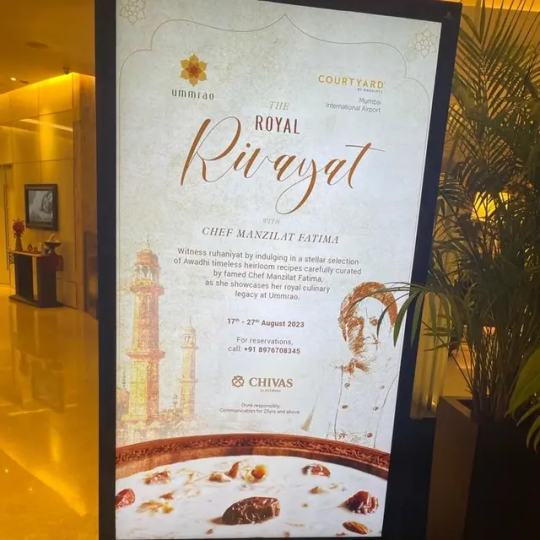

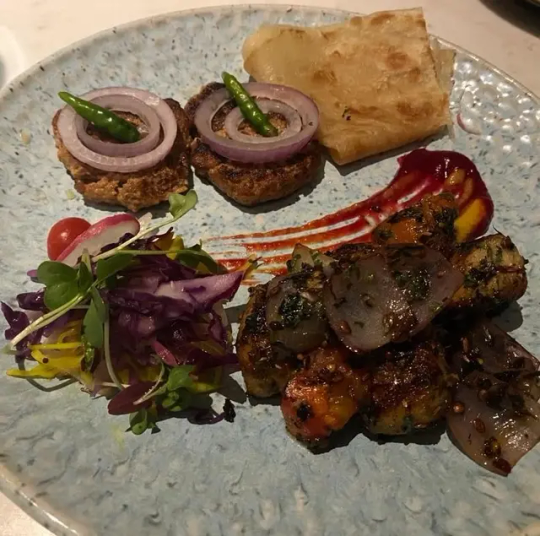
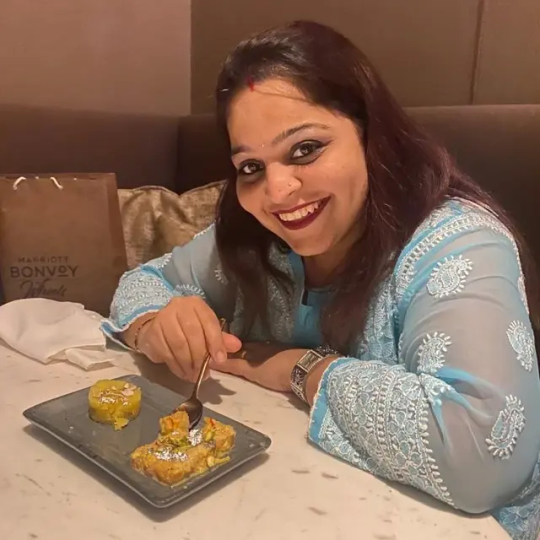
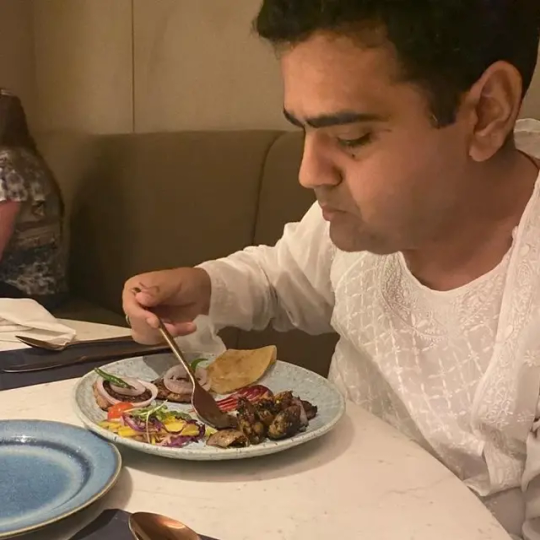

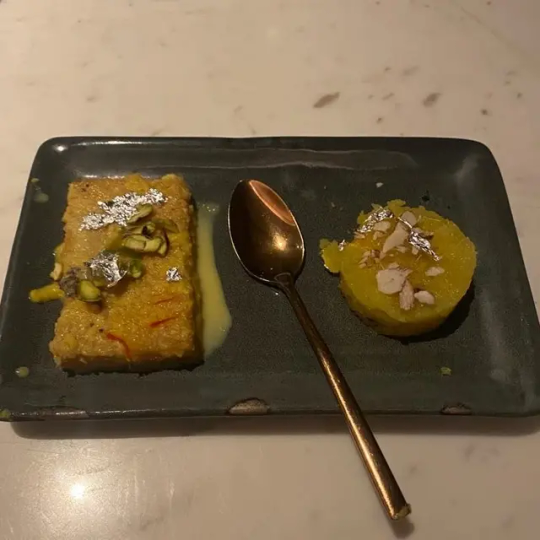
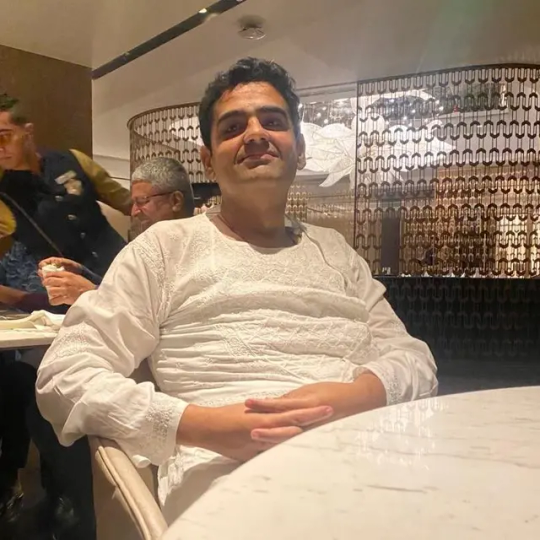
Indulging in Awadhi cuisine is a sensory journey that captivates taste buds with rich flavors & aromas. From tender galouti kebabs to the regal biryani, each dish tells a story of the royal kitchens of Lucknow. Chef Manzilat created magic yet again at Courtyard by Marriott, Mumbai with the best of kebabs, kormas, biryani, and desserts. Food yesterday was not just a meal; it was a #gastronomic experience that transported us to the era of #Nawabs. #Awadhi #AwadhiFood #AwadhiCuisine #FoodAndAllThat #FoodTraditions #Lucknow #Kolkata
0 notes
Text
From Street Food to Royal Feasts: Celebration of India's Culinary Heritage
India is a country known for its rich cultural heritage, vibrant traditions, and diverse cuisines. The culinary landscape of India is a treasure trove of flavors, spices, and culinary techniques that have evolved over centuries. From the bustling streets of Mumbai to the palatial kitchens of Rajasthan, India's culinary heritage is a tapestry of regional specialties and age-old recipes passed down through generations.
One cannot talk about Indian cuisine without mentioning its street food culture. The streets of India are a gastronomic delight, with vendors and food stalls offering a myriad of delectable treats. From crispy samosas and spicy pani puri to flavorful pav bhaji and tangy chaat, street food in India is a celebration of flavors and textures. These humble yet mouthwatering delicacies often provide a glimpse into the local culinary traditions and are a favorite among locals and tourists alike.
As we delve deeper into India's culinary heritage, we discover the opulence and grandeur of royal feasts. The Maharajas and Nawabs of India were known for their extravagant banquets, where no expense was spared to create lavish spreads fit for royalty. These feasts showcased the finest ingredients, intricate preparations, and a symphony of flavors. From aromatic biryanis and rich kormas to delicate kebabs and indulgent desserts like gulab jamun and phirni, the royal cuisine of India is a testament to the country's culinary excellence.
When it comes to experiencing the best of Indian cuisine in Edmonton, one restaurant stands out: Amritsar Junction. Known for its authentic flavors and warm hospitality, Amritsar Junction brings the essence of India's culinary heritage to the heart of Alberta. With a menu inspired by the diverse regional cuisines of India, Amritsar Junction offers a gastronomic journey through the flavors of the subcontinent.
The menu at Amritsar Junction features an array of mouthwatering dishes that showcase the best of Indian cuisine. From street food favorites like tangy chaats and crispy pakoras to royal delicacies like fragrant biryanis and succulent kebabs, every dish is crafted with care and precision. The chefs at Amritsar Junction use traditional cooking techniques and high-quality ingredients to ensure an authentic and unforgettable dining experience.
For those seeking an authentic taste of India's culinary heritage, Amritsar Junction is undoubtedly the best Indian cuisine restaurant in Edmonton. With its diverse menu, exquisite flavors, and warm hospitality, it offers a culinary experience that is both memorable and satisfying. Whether you are craving the vibrant street food of Mumbai or the royal feasts of Rajasthan, a visit to Amritsar Junction is sure to delight your taste buds and transport you to the enchanting world of Indian cuisine.
In conclusion, India's culinary heritage is a celebration of flavors, traditions, and culinary craftsmanship. From the bustling streets of India to the palatial kitchens of royalty, the country's cuisine is a tapestry woven with spices, flavors, and techniques that have stood the test of time. Amritsar Junction, with its commitment to authenticity and excellence, brings the best of Indian cuisine to Edmonton, allowing diners to embark on a culinary journey through the diverse flavors of India.
#indian restaurants in edmonton#best indian take out restaurant in edmonton canada#taste of indian restaurant edmonton#street food#top indian street food in edmonton#edmonton
0 notes